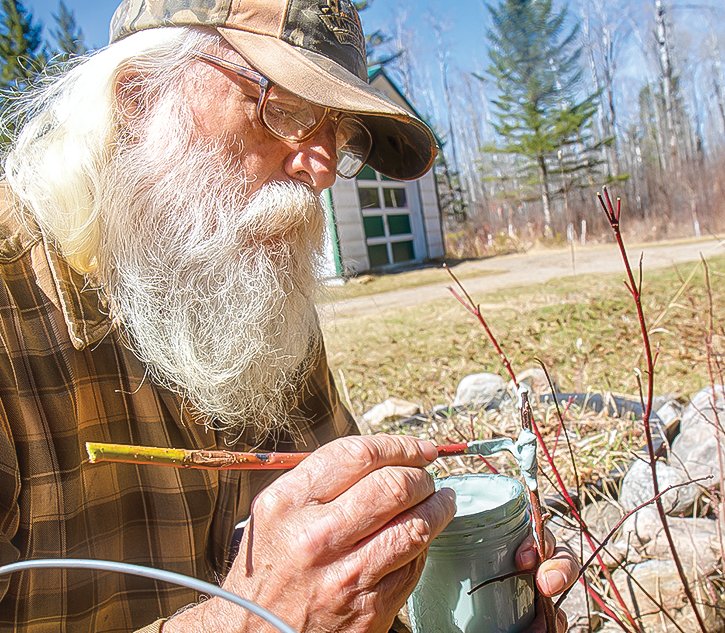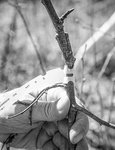Support the Timberjay by making a donation.
Graft is good when it comes to trees
One tree becomes many in the hands of this Greaney man
GREANEY- It could be said that Beryl Novak lives in a small house in the forest near Greaney, but that would be a half-truth.While the forest obscures any view of his house from Sethers Rd., a trip …
This item is available in full to subscribers.
Attention subscribers
To continue reading, you will need to either log in to your subscriber account, or purchase a new subscription.
If you are a current print subscriber, you can set up a free website account and connect your subscription to it by clicking here.
If you are a digital subscriber with an active, online-only subscription then you already have an account here. Just reset your password if you've not yet logged in to your account on this new site.
Otherwise, click here to view your options for subscribing.
Please log in to continue |
Graft is good when it comes to trees
One tree becomes many in the hands of this Greaney man
GREANEY- It could be said that Beryl Novak lives in a small house in the forest near Greaney, but that would be a half-truth.
While the forest obscures any view of his house from Sethers Rd., a trip down the driveway ends at an abode under open skies and surrounded by an orchard, one that’s been tailored to Novak’s whims and desires by the practice of tree grafting.
With a casual glance, the bare trees don’t look any different from most other orchards where apple and crabapple trees dominate. But upon closer inspection, and with a little guidance from Novak, slight bulges and different bark colors found in branches of a single tree reveal his grafting handiwork.
“That tree right there, when it was smaller, I had 25 varieties on that,” Novak said. “I’m down to maybe ten or so – they die off or break or something.”
Novak said he first tried grafting “over 20 years ago, well over that.”
“I’d read up on it,” he said. “I purchased a couple of trees and I figured, well, I’ll take cuttings out and put them on some wild ones and, my gosh, some of them grew.”
Novak’s engagement with grafting grew, too.
“I really went into it for a while – I would go around and do custom grafting for people and I was selling trees and stuff. I don’t really do much of that custom grafting anymore.”
But it’s hard to turn down a neighbor, and Novak had spent the morning down the road at the home of Jim Prepodnik.
“At Jim’s today I put 16 grafts on that tree and they’re all different,” he said.
Novak’s orchard has an international flair, as he’s ordered different varieties of tree scions (the pieces to be grafted onto a rootstock tree) from all over the world.
“I’ve probably put in several hundred orders over the years,” he said. “I ordered some stuff last fall, but nothing came this year. So, it’s either one, they didn’t cut anything because of that COVID stuff. Or two, it’s a government deal, and maybe they got tired of sending.”
Novak pulled a scion out of a wrapped packet, picked up his equipment, and walked over to a tall shoot to demonstrate a cleft graft.
“This is just a wild shoot that came on – it’s an apple,” he said.
Pulling out his knife, he trimmed off the shoot about three feet high and then cut a notch down the middle. Then he took the scion, trimmed a small piece from the end, and whittled the cut end down to a sharp wedge.
“You only want one bud,” he said. “You want all the energy you can to go into this one bud to grow.”
Next, he slipped the wedge into the notch. Ideally, the width of the two pieces being joined is the same.
“You want it so that it’s flush. That way the cambium layers line up,” Novak said. “If you get it too small you can still get one side to come together. You don’t want a fatter one going in there.”
Once properly aligned, Novak wrapped the splice with a wide rubber band and, using a whittled stick as a brush, covered it all with liquid wax. The band and wax are specialty grafting items that can be found in different varieties, he said.
“And there you go,” he said, applying the final daub of wax. “In a few years you’ve got yourself a $50 tree for nothing.”
While a decorative flowering pear tree grows in one corner of the orchard, Novak discovered that regular pear trees don’t do well in this region. While growing regions have been established for different varieties of trees, numerous factors come into play that may determine the viability of a particular graft, and Novak’s had numerous failures to go along with his obvious successes. Apples and crabapples are his primary fruit producers, and with grafting, a single tree will produce multiple varieties, including some that may ripen earlier or later than others.
Novak said grafting is also a good way to rejuvenate a faltering tree.
“Let’s say you have an old flowering crab or something in the backyard and you’re thinking about cutting it down,” he said. “Well, you can top graft in eating varieties, and it will be worth something.”
Over the years, Novak said that the best crabapple variety for grafting in this area that he’s come across is Chestnut. Centennial, Dolgo, and Whitney varieties also do well, he said.
His list for grafting apples is longer, and includes the following varieties: Norland, State Fair, Goodland, Parkland, Haralson, Lodi, Redwell, Regent, and Zestar.
He’s obviously tried them all with good success, as a look around the orchard will tell. So, with all of those fruit trees and all those varieties, what does he do with the bountiful harvest?
“I just give the apples away when people show up in the fall. That’s the only time I see some of these people,” Novak chuckled.









